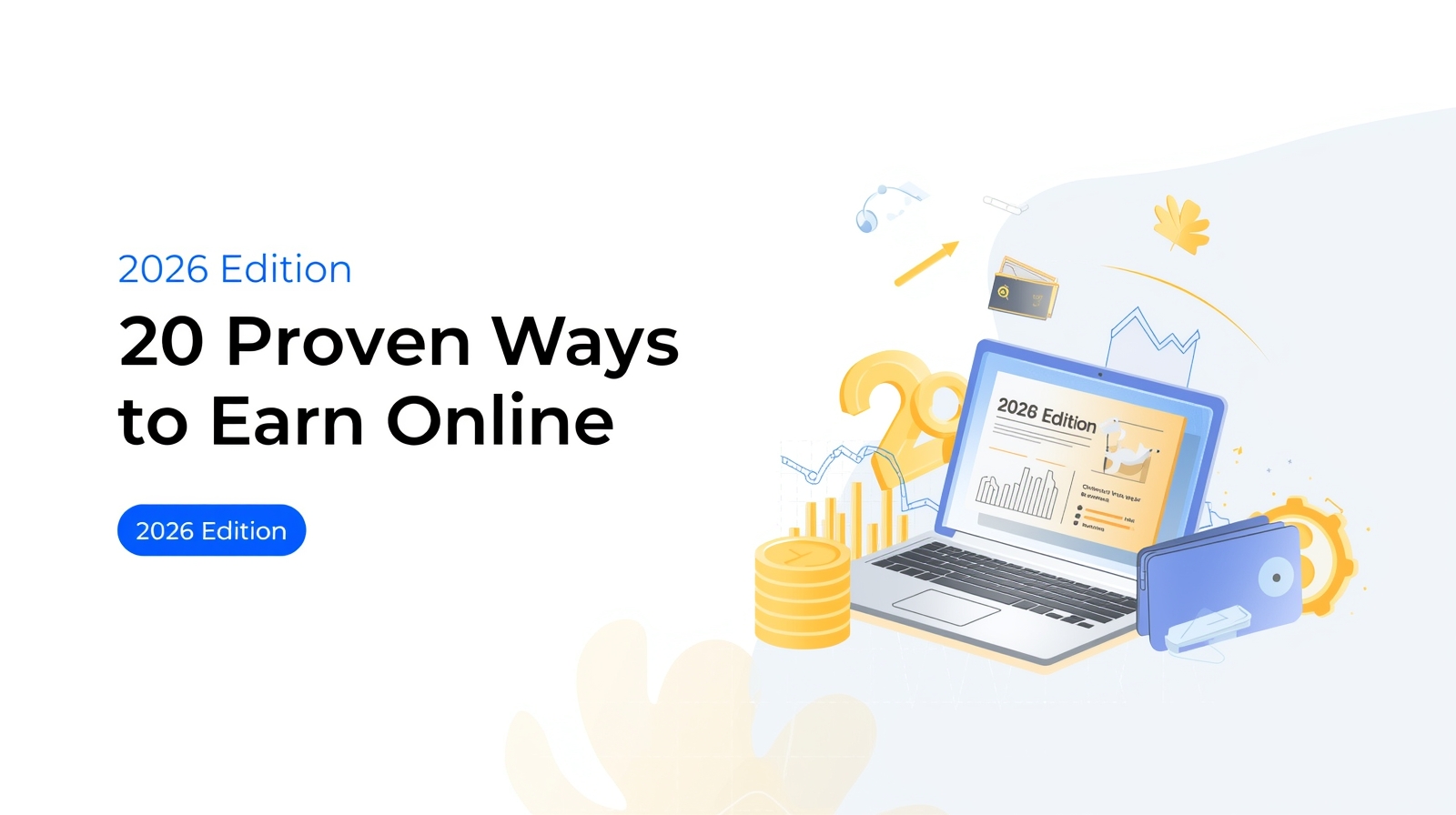1. Introduction — why diversify in 2026
If you learned one thing from the 2020s, it’s this: sticking to a single source of income online is like balancing on a pogo stick while juggling flaming torches. It can work — for a while — but you’ll sleep better if you build multiple streams. In 2026, platforms will keep changing monetization rules, ads will shift, and niches will rise and fall. That’s why this guide focuses not on “get rich quick” hacks, but on durable streams you can start, combine, and scale.
2. The big picture: the creator & freelance economies
The online economy keeps ballooning. The “creator economy” — the ecosystem of people monetizing content and community — was estimated in the low hundreds of billions in 2024 and continues fast growth into the mid/late 2020s. Platforms and brand deals are driving a surge of ad and creator-focused revenue. Freelancing platforms have also grown quickly, with projections showing freelancing as an increasingly large share of the workforce and freelance marketplaces expanding in value. These macro trends mean more demand for creators, freelancers, and performance-based partnerships — but also more competition, so strategy matters.
3. Passive-ish streams (set up once, earn many times)
“Passive” online income almost always means “front-loaded work, later returns.” Here are realistic passive-ish options and how to start them.
a) Affiliate marketing
What it is: Recommend products via links; earn commission for sales or leads.
Why it works: Performance-based, low overhead, many programs (Amazon, niche retailers, software affiliates).
How to start: pick a niche you know, build content (reviews, product roundups, how-tos), join relevant affiliate programs, disclose links clearly. Expect slow growth: affiliate income scales with trust and traffic. Industry numbers show affiliate marketing is a sizable and growing channel for advertisers and creators.
b) Digital products — templates, courses, ebooks
What it is: Create one asset (course, template, eBook) and sell copies.
Why: High margins, repeatable sales, can be sold on your site, Gumroad, Teachable, or marketplaces.
How to start: validate demand via a landing page or pre-sales, create a minimal viable product, collect testimonials, iterate. Put a small ad budget behind launches to jump-start sales.
c) Print-on-demand and low-touch commerce
What it is: Designs sold on shirts, mugs, posters with fulfillment handled by a provider.
Why: No inventory; good for niche audiences with a brand.
How to start: test designs, use your own audience to promote, keep margins realistic.
d) Royalties & licensing (music, photos, code)
What it is: License intellectual property — stock photos, music, templates, or code packages.
How to start: upload to marketplaces (e.g., stock photo sites, music libraries, theme marketplaces), track where sales come from, polish metadata for discoverability.
4. Active-income online jobs (freelancing & remote work)
If you need income faster and reliably, this bucket is where you should focus. Active income requires ongoing time investment but often pays quicker.
a) Freelance services (writing, design, dev, marketing)
How to win: specialize (e.g., “WordPress performance dev for small SaaS”), build a small portfolio site, gather 2–3 strong case studies, use Upwork/Fiverr/agency referrals for early gigs, then move to direct clients. Upwork and similar platforms show continued growth in freelance demand — skills-based freelancers report expanding opportunities.
b) Remote full-time/contract work
How to approach: target companies hiring remote contractors, optimize LinkedIn and GitHub, apply with tailored pitches and short portfolios. Contracts often pay better and offer predictability.
c) Consulting & retained services
If you have domain expertise, offer monthly retainers for strategy or ongoing work. Retainers give predictable revenue and scale via packaged deliverables.
d) Microservices & quick gigs
Short tasks (e.g., UX audits, quick audits, short video edits) can be sold via marketplaces or your own site — useful to fill lean periods.
5. Creator-first monetization (content + community)
Creators have many options to turn attention into income. The key: combine revenue types (ads + sponsorships + direct fan support).
a) Ad revenue (YouTube, podcasts, in-platform ads)
YouTube remains one of the best scales for video monetization via ads, memberships, and sponsorships. Platform ad revenue dynamics change, but creator-driven ad dollars are large and growing. Expect that ad income can vary month-to-month.
b) Sponsorships & brand deals
What: Brands pay creators to promote products. Best for creators with clear audience fit and solid engagement. How to land: pitch with audience stats, past campaign results, and creative concepts.
c) Fan-supported models (Patreon, Substack, Buy Me a Coffee)
Subscription models let fans pay directly. Newsletters (Substack) and membership platforms (Patreon, Memberful) work well for niche, loyal audiences. Several creators find subscriptions more stable than ad-only income.
d) Live commerce & gifting (TikTok, Twitch, Instagram Live)
Short-form live shopping and tipping/gifting are growing. TikTok, for example, has creator rewards and live features creators can monetize with gifts and commerce. Monetization rules differ by platform; lean into the platform where your content naturally fits.
e) Micro-courses & creator academies
Creators can turn lessons into paid courses or membership-only mini-classes. These often convert better when buyers already trust the creator.
6. Productized and commerce routes (digital + physical)
a) E-commerce & dropshipping
Good for product-focused entrepreneurs. Dropshipping reduces inventory risk but demands customer service and marketing. Use data (ads, influencers) to test product-market fit.
b) Selling services as products
Package a service (e.g., “30-day SEO boost”) with a fixed scope and price. Easier to sell and scale than hourly work.
c) Printables and templates
For audiences like educators, planners, or small business owners, templates sell well on Etsy, Gumroad, or your site.
d) Bundles and cross-sells
Combine small digital products into bundles to increase average order value. Use email sequences to convert past buyers on new offers.
7. Investing, finance, and algorithmic income
These are more advanced and require capital and risk tolerance.
a) Dividend and dividend-growth investing
Buy and hold stocks or ETFs paying dividends. Not instant, but passive and stable if chosen carefully.
b) Peer-to-peer lending & lending platforms
Potentially higher yields, but riskier. Do due diligence.
c) Algorithmic/growth experiments (ads arbitrage, traffic-to-affiliate)
Some entrepreneurs use paid traffic funnels to arbitrage returns via affiliate commissions — profitable when unit economics are positive, but risky if ad prices rise.
8. How to pick the best 2–3 streams for you
You can’t do everything well at once. Pick 2–3 complementary streams based on:
-
Time available (part-time vs full-time).
-
Skillset (writing, video, design, dev).
-
Payback speed (freelancing = fast, course = medium, affiliate passive = slow).
-
Your audience (do they prefer long-form guides, short videos, paid memberships?).
Example combos:
-
Writer with audience → newsletter (free) + paid Substack + freelance content work.
-
Developer → productized dev service + niche SaaS plugin + YouTube tutorials monetized.
-
Designer → Etsy templates + Shopify store + paid workshops.
9. Practical launch checklist (first 90 days)
Day 0: pick 1 primary stream and 1 secondary stream. Focus beats scattered effort.
First 30 days (Validate):
-
Build a simple landing page describing your offer.
-
Run a 1–2 week test (pre-sales, small ad test, or email signups).
-
Create 3–5 pieces of cornerstone content.
Days 31–60 (Optimize & sell):
-
Launch minimally viable product or service.
-
Collect 3-5 testimonials or case studies.
-
Automate intake (payment, scheduling, delivery).
Days 61–90 (Scale):
-
Build an email funnel.
-
Add a paid promotion (small ad spend or influencer collab).
-
Systematize delivery (templates, SOPs) so you can scale without burning out.
Use simple metrics: revenue, conversion rate, cost per sale, and retention.
10. Common mistakes and how to avoid them
Mistake 1: Chasing every shiny platform.
Fix: Master one platform that fits your content and audience before expanding.
Mistake 2: Ignoring your existing audience.
Fix: Ask them what they want and sell solutions, not features.
Mistake 3: Undercharging or no clear productization.
Fix: Offer packaged services and test price elasticity with small cohorts.
Mistake 4: No diversification.
Fix: After the primary stream stabilizes, add one complementary stream (e.g., course or affiliate offers).
Mistake 5: Relying on a single platform for distribution.
Fix: Own the relationship (email list) and use platform audiences for discovery.
11. Conclusion & next steps
The online income landscape in 2026 rewards creators and skilled freelancers — but success depends on strategy, consistent value delivery, and smart diversification. Start with one primary income stream and add one complementary stream within 90 days. Measure results, iterate, and protect yourself by owning assets (email list, product assets) rather than relying only on third-party platforms.

Quick resources & recommended next steps
-
If you’re just starting: pick freelancing + a small digital product. Freelancing brings cash; the product builds passive potential.
-
If you already have an audience: test a paid membership or micro-course — your conversion costs will be lower.
-
Track market signals: affiliate marketing, creator subscriptions, and freelance platforms are growing — use them—but don’t forget fundamentals: great content, strong offers, and consistent delivery.


